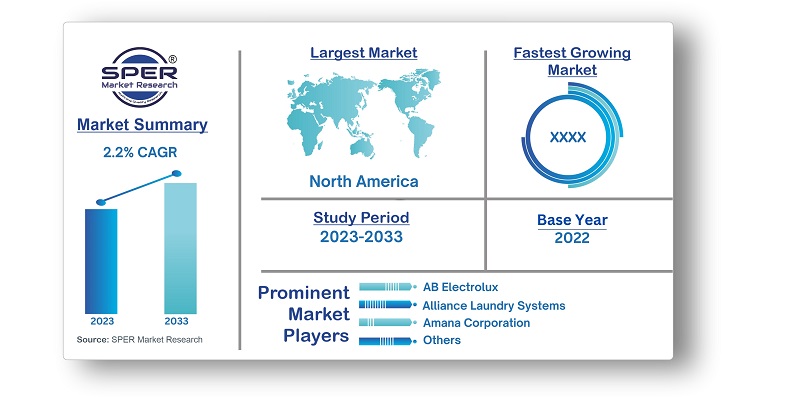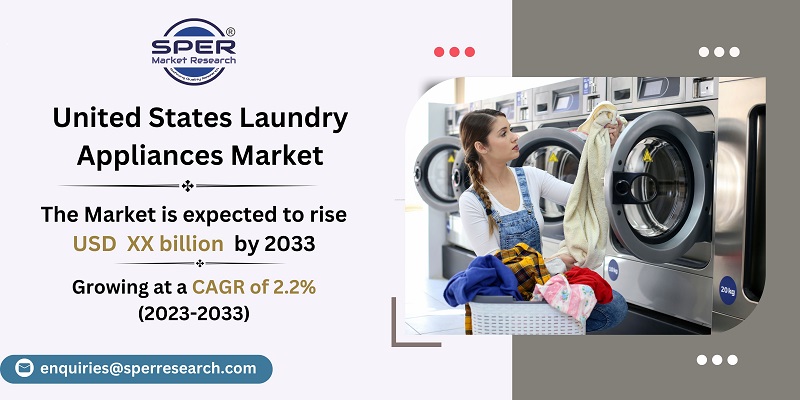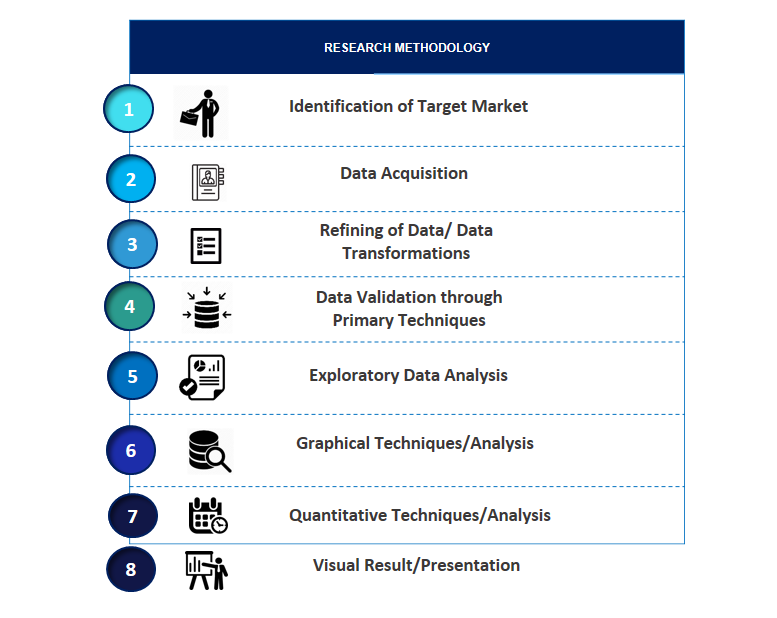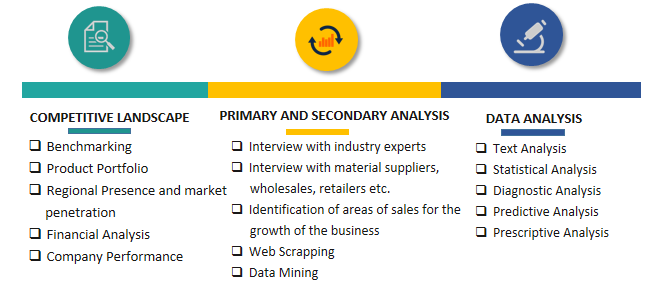
US Laundry Appliances Market Growth, Size, Trends, Demand, Revenue, Share and Future Outlook
United States Laundry Appliances Market Size- By Type, By Product, By Technology, By Distribution Channel- Regional Outlook, Competitive Strategies and Segment Forecast to 2033
| Published: Jan-2024 | Report ID: FMCG2402 | Pages: 1 - 108 | Formats*: |
| Category : Consumer & Retail | |||

- There are numerous opportunities for development and expansion in the laundry appliances market:
- Product Innovation: The market for multipurpose, environmentally friendly, and energy-efficient laundry appliances is one that manufacturers can profit from.
- E-Commerce and Online Sales: Growing internet usage provides a wide range of opportunities for washing appliance marketing and sales online.
- Rural Market Penetration: Investigating unexplored rural markets may present fresh development opportunities.
- Appliance Rental Services: Renting out washing appliances could draw customers who would rather have access than ownership.
- Maintenance and Repair Expenses: The possible long-term maintenance and repair costs of sophisticated appliances may put off some buyers.
- Market Saturation: The market is getting close to saturation, which means manufacturers will face more intense competition and narrower profit margins.
- Environmental Impact: Concerns over the environmental effects of appliance manufacturing and disposal are growing among consumers.

| Report Metric | Details |
| Market size available for years | 2019-2033 |
| Base year considered | 2022 |
| Forecast period | 2023-2033 |
| Segments covered | By Type, By Product, By Technology, By Distribution Channel |
| Regions covered | Eastern Region, Northern Region, Southern Region, Western Region |
| Companies Covered | AB Electrolux, Alliance Laundry Systems, Amana Corporation, Bosch, Frigidaire, GE Appliances, LG Electronics, Miele, Samsung, Whirlpool Corporation, Others |
- Apartment Dwellers
- Appliance Repair Services
- Appliance Retailers
- Commercial Businesses
- Hotels and Hospitality
- Households
- Laundromats
- Laundry Appliance Manufacturers
- Others
| By Type: |
|
| By Product: |
|
| By Technology: |
|
| By Distribution Channel: |
|
- United States Laundry Appliances Market Size (FY’2023-FY’2033)
- Overview of United States Laundry Appliances Market
- Segmentation of United States Laundry Appliances Market By Type (Built-in, Freestanding)
- Segmentation of United States Laundry Appliances Market By Product (Dryers, Electric Smoothing Irons, Washing Machine, Others)
- Segmentation of United States Laundry Appliances Market By Technology (Automatic, Semi-Automatic/ Manual, Others)
- Segmentation of United States Laundry Appliances Market By Distribution Channel (Online, Specialty Stores, Supermarkets and Hypermarkets, Other Distribution Channels)
- Statistical Snap of United States Laundry Appliances Market
- Expansion Analysis of United States Laundry Appliances Market
- Problems and Obstacles in United States Laundry Appliances Market
- Competitive Landscape in the United States Laundry Appliances Market
- Impact of COVID-19 and Demonetization on United States Laundry Appliances Market
- Details on Current Investment in United States Laundry Appliances Market
- Competitive Analysis of United States Laundry Appliances Market
- Prominent Players in the United States Laundry Appliances Market
- SWOT Analysis of United States Laundry Appliances Market
- United States Laundry Appliances Market Future Outlook and Projections (FY’2023-FY’2033)
- Recommendations from Analyst
1.1. Scope of the report1.2. Market segment analysis
2.1. Research data source2.1.1. Secondary Data2.1.2. Primary Data2.1.3. SPER’s internal database2.1.4. Premium insight from KOL’s2.2. Market size estimation2.2.1. Top-down and Bottom-up approach2.3. Data triangulation
4.1. Driver, Restraint, Opportunity and Challenges analysis4.1.1. Drivers4.1.2. Restraints4.1.3. Opportunities4.1.4. Challenges4.2. COVID-19 Impacts of the United States Laundry Appliances Market
5.1. SWOT Analysis5.1.1. Strengths5.1.2. Weaknesses5.1.3. Opportunities5.1.4. Threats5.2. PESTEL Analysis5.2.1. Political Landscape5.2.2. Economic Landscape5.2.3. Social Landscape5.2.4. Technological Landscape5.2.5. Environmental Landscape5.2.6. Legal Landscape5.3. PORTER’s Five Forces5.3.1. Bargaining power of suppliers5.3.2. Bargaining power of buyers5.3.3. Threat of Substitute5.3.4. Threat of new entrant5.3.5. Competitive rivalry5.4. Heat Map Analysis
6.1. United States Laundry Appliances Market Manufacturing Base Distribution, Sales Area, Product Type6.2. Mergers & Acquisitions, Partnerships, Product Launch, and Collaboration in United States Laundry Appliances Market
7.1. United States Laundry Appliances Market Value Share and Forecast, By Type, 2023-20337.2. Built in7.3. Freestanding
8.1. United States Laundry Appliances Market Value Share and Forecast, By Product, 2023-20338.2. Dryers8.3. Electric Smoothing Irons8.4. Washing Machine8.5. Others
9.1. United States Laundry Appliances Market Value Share and Forecast, By Technology, 2023-20339.2. Automatic9.3. Semi-Automatic/ Manual9.4. Others
10.1. United States Laundry Appliances Market Value Share and Forecast, By Distribution Channel, 2023-203310.2. Online10.3. Specialty Stores10.4. Supermarkets and Hypermarkets10.5. Other Distribution Channels
11.1. United States Laundry Appliances Market Size and Market Share
12.1. United States Laundry Appliances Market Size and Market Share By Type (2019-2026)12.2. United States Laundry Appliances Market Size and Market Share By Product Type (2027-2033)
13.1. United States Laundry Appliances Market Size and Market Share By Product (2019-2026)13.2. United States Laundry Appliances Market Size and Market Share By Product (2027-2033)
14.1. United States Laundry Appliances Market Size and Market Share By Technology (2019-2026)14.2. United States Laundry Appliances Market Size and Market Share By Technology (2027-2033)
15.1. United States Laundry Appliances Market Size and Market Share By Distribution Channel (2019-2026)15.2. United States Laundry Appliances Market Size and Market Share By Distribution Channel (2027-2033)
16.1. United States Laundry Appliances Market Size and Market Share By Region (2019-2026)16.2. United States Laundry Appliances Market Size and Market Share By Region (2027-2033)16.3. Eastern Region16.4. Northern Region16.5. Southern Region
16.6. Western Region
17.1. AB Electrolux17.1.1. Company details17.1.2. Financial outlook17.1.3. Product summary17.1.4. Recent developments17.2. Alliance Laundry Systems17.2.1. Company details17.2.2. Financial outlook17.2.3. Product summary17.2.4. Recent developments17.3. Amana Corporation17.3.1. Company details17.3.2. Financial outlook17.3.3. Product summary17.3.4. Recent developments17.4. Bosch17.4.1. Company details17.4.2. Financial outlook17.4.3. Product summary17.4.4. Recent developments17.5. Frigidaire17.5.1. Company details17.5.2. Financial outlook17.5.3. Product summary17.5.4. Recent developments17.6. GE Appliances17.6.1. Company details17.6.2. Financial outlook17.6.3. Product summary17.6.4. Recent developments17.7. LG Electronics17.7.1. Company details17.7.2. Financial outlook17.7.3. Product summary17.7.4. Recent developments17.8. Miele17.8.1. Company details17.8.2. Financial outlook17.8.3. Product summary17.8.4. Recent developments17.9. Samsung17.9.1. Company details17.9.2. Financial outlook17.9.3. Product summary17.9.4. Recent developments17.10. Whirlpool Corporation17.10.1. Company details17.10.2. Financial outlook17.10.3. Product summary17.10.4. Recent developments17.11. Others
SPER Market Research’s methodology uses great emphasis on primary research to ensure that the market intelligence insights are up to date, reliable and accurate. Primary interviews are done with players involved in each phase of a supply chain to analyze the market forecasting. The secondary research method is used to help you fully understand how the future markets and the spending patterns look likes.
The report is based on in-depth qualitative and quantitative analysis of the Product Market. The quantitative analysis involves the application of various projection and sampling techniques. The qualitative analysis involves primary interviews, surveys, and vendor briefings. The data gathered as a result of these processes are validated through experts opinion. Our research methodology entails an ideal mixture of primary and secondary initiatives.



Frequently Asked Questions About This Report
PLACE AN ORDER
Year End Discount
Sample Report
Pre-Purchase Inquiry
NEED CUSTOMIZATION?
Request CustomizationCALL OR EMAIL US
100% Secure Payment






Related Reports
Our Global Clients
Our data-driven insights have influenced the strategy of 200+ reputed companies across the globe.




















